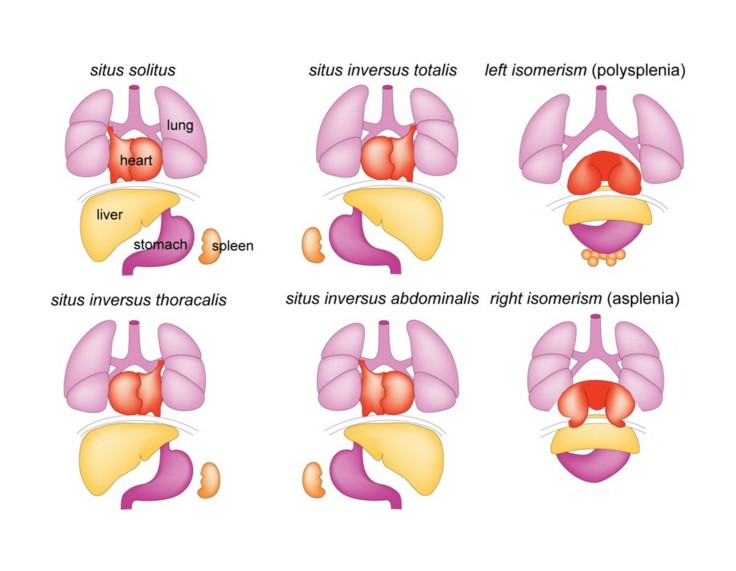[MIM 208 530, 270 100, 306 955, 601 086, 605 376, 606 325, 613 751, 614 779, 616 749, 617 205]
Incidence: 1/6,000 to 1/20,000 live births.
The genetics is complex: mutations have been identified in the LEFTY2 (1q42.12,) ACVR2B (2p22.2), NODAL (10q22.1), CFC1 (2q21.1), MMP21 (10q26.2), GDF1 (19p13 .11), FOXH1 (8q24.3), CCDC11 (18q21.1) et INVERSINE genes in patients with a heterotaxy but they were all heterozygous, which suggests that it is rather a digenism. Moreover, the ZIC3 gene (Zinc-finger protein of cerebellum)(Xq26.2) has been found to be responsible for the X-linked heredity.
Malformative syndrome where the disposition of internal organs (thoracic or visceral) is different from the usual left-right asymmetry. It results from an abnormality of installation of left-right asymmetry during embryogenesis. Embryologically, it occurs on day 23 at the time when the initial cardiac atrioventricular channel starts its axial twist: this movement depends on the presence of normal cilia on the cells and causes a displacement of cells and initiates the asymmetry of organogenesis. This explains the frequency of heterotaxy in primary ciliary dyskinesia (see this term).
Different situations:
- situs solitus : normal
- situs inversus : total inversion of the organs in the thorax and abdomen (mirror image of the normal situation)
- situs ambiguus: some organs match with 'situs solitus' while others match with 'situs inversus'.

Definitions:
- isomerism: in the context of cardiac malformation, a situation where some paired structures located on both sides of the left-right axis are the mirror image of the other one.
- left isomerism: on the right side, mirror image of the left: presence of 2 left atria, a heart defect (rare), polysplenism, and two bilobed lungs
- right isomerism: on the left side, mirror image of the right: presence of 2 right atria, a heart defect (frequent), asplenia, and of two trilobed lungs
- laterality defect: lack of asymmetry of an organ or structure: for example, a median liver or a persistent left superior vena cava (see this term)
Numerous malformations can be associated with heterotaxy:
- cardiac: all, dextrocardia, conduction disorders, left superior vena cava, interruption of the inferior vena cava, total abnormal systemic venous return (into the left atrium)
- central nervous system: encephalocele, Dandy-Walker malformation, holoprosencephaly
- skeletal: defects, vertebrae, sacrum
- abdominal: omphalocele, intestinal malrotation, anal atresia or stenosis, gastric duplication, diaphragmatic hernia, biliary atresia
- respiratory: laryngeal cleft, laryngeal atresia, tracheal bronchus (see those terms)
- genitourinary: horseshoe kidney, renal agenesis, malformations of the uterus
- craniofacial: choanal atresia, agnathia, cleft or lip palate
Anesthetic implications:
according to the associated malformations (see asplenia and polysplenia).
In case of total abnormal systemic venous return, where all the blood drained by the upper and lower venae cavae drain directly into the left atrium, survival is only possible with a ASD, a VSD or a large ductus arteriosus. The importance of symptoms (cyanosis, heart failure) depends on the size of the communication between the 2 circulations. The presence of a right to left shunt at the level of the left atrium and a right to left shunt at the level of the communication between systemic and pulmonary circulations (with a more or less important cyanosis) constitutes a high risk of paradoxical embolism.
References :
- Williams GD, Feng A.
Heterotaxy syndrome : implications for anesthesia management.
J Cardiothorac Vascul Anesth 2010; 24: 834-44. - Kerai S, Saxena KN, Sehrawat L, Taneja B.
Anesthesia for noncardiac intervention in a patient with total anomalous systemic venous return.
Pediatr Anesth 2016 ; 26 : 324-5
Updated: March 2021